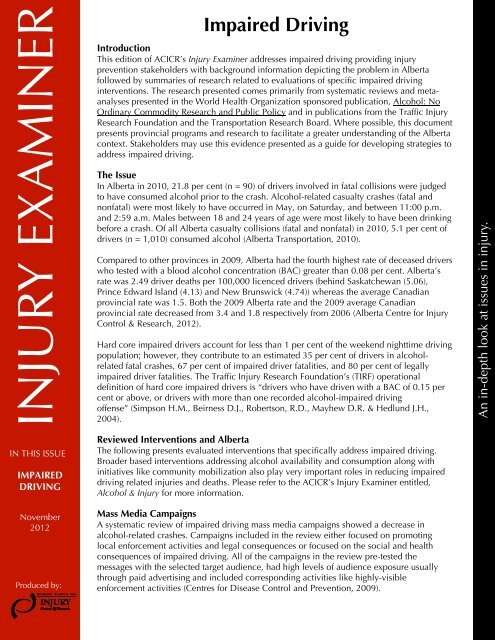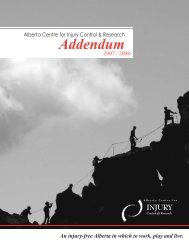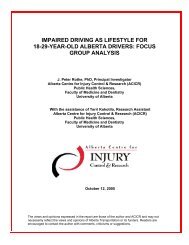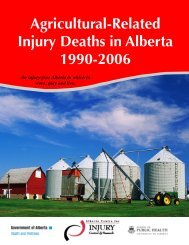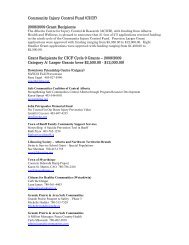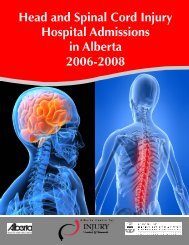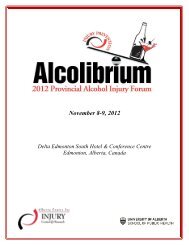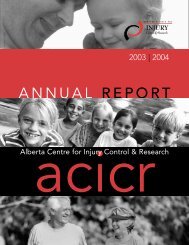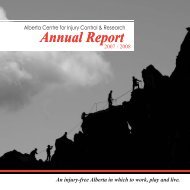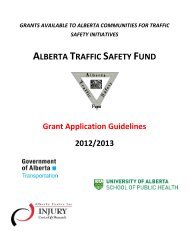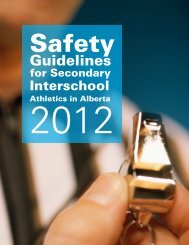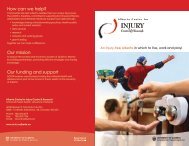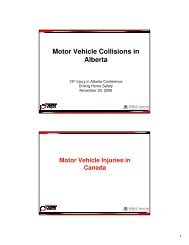Impaired Driving - Alberta Centre for Injury Control & Research
Impaired Driving - Alberta Centre for Injury Control & Research
Impaired Driving - Alberta Centre for Injury Control & Research
Create successful ePaper yourself
Turn your PDF publications into a flip-book with our unique Google optimized e-Paper software.
INJURY EXAMINER<br />
<strong>Impaired</strong> <strong>Driving</strong><br />
Introduction<br />
This edition of ACICR’s <strong>Injury</strong> Examiner addresses impaired driving providing injury<br />
prevention stakeholders with background in<strong>for</strong>mation depicting the problem in <strong>Alberta</strong><br />
followed by summaries of research related to evaluations of specific impaired driving<br />
interventions. The research presented comes primarily from systematic reviews and metaanalyses<br />
presented in the World Health Organization sponsored publication, Alcohol: No<br />
Ordinary Commodity <strong>Research</strong> and Public Policy and in publications from the Traffic <strong>Injury</strong><br />
<strong>Research</strong> Foundation and the Transportation <strong>Research</strong> Board. Where possible, this document<br />
presents provincial programs and research to facilitate a greater understanding of the <strong>Alberta</strong><br />
context. Stakeholders may use this evidence presented as a guide <strong>for</strong> developing strategies to<br />
address impaired driving.<br />
The Issue<br />
In <strong>Alberta</strong> in 2010, 21.8 per cent (n = 90) of drivers involved in fatal collisions were judged<br />
to have consumed alcohol prior to the crash. Alcohol-related casualty crashes (fatal and<br />
nonfatal) were most likely to have occurred in May, on Saturday, and between 11:00 p.m.<br />
and 2:59 a.m. Males between 18 and 24 years of age were most likely to have been drinking<br />
be<strong>for</strong>e a crash. Of all <strong>Alberta</strong> casualty collisions (fatal and nonfatal) in 2010, 5.1 per cent of<br />
drivers (n = 1,010) consumed alcohol (<strong>Alberta</strong> Transportation, 2010).<br />
Compared to other provinces in 2009, <strong>Alberta</strong> had the fourth highest rate of deceased drivers<br />
who tested with a blood alcohol concentration (BAC) greater than 0.08 per cent. <strong>Alberta</strong>’s<br />
rate was 2.49 driver deaths per 100,000 licenced drivers (behind Saskatchewan (5.06),<br />
Prince Edward Island (4.13) and New Brunswick (4.74)) whereas the average Canadian<br />
provincial rate was 1.5. Both the 2009 <strong>Alberta</strong> rate and the 2009 average Canadian<br />
provincial rate decreased from 3.4 and 1.8 respectively from 2006 (<strong>Alberta</strong> <strong>Centre</strong> <strong>for</strong> <strong>Injury</strong><br />
<strong>Control</strong> & <strong>Research</strong>, 2012).<br />
Hard core impaired drivers account <strong>for</strong> less than 1 per cent of the weekend nighttime driving<br />
population; however, they contribute to an estimated 35 per cent of drivers in alcoholrelated<br />
fatal crashes, 67 per cent of impaired driver fatalities, and 80 per cent of legally<br />
impaired driver fatalities. The Traffic <strong>Injury</strong> <strong>Research</strong> Foundation’s (TIRF) operational<br />
definition of hard core impaired drivers is “drivers who have driven with a BAC of 0.15 per<br />
cent or above, or drivers with more than one recorded alcohol-impaired driving<br />
offense” (Simpson H.M., Beirness D.J., Robertson, R.D., Mayhew D.R. & Hedlund J.H.,<br />
2004).<br />
An in-depth look at issues in injury.<br />
IN THIS ISSUE<br />
IMPAIRED<br />
DRIVING<br />
November<br />
2012<br />
Produced by:<br />
Reviewed Interventions and <strong>Alberta</strong><br />
The following presents evaluated interventions that specifically address impaired driving.<br />
Broader based interventions addressing alcohol availability and consumption along with<br />
initiatives like community mobilization also play very important roles in reducing impaired<br />
driving related injuries and deaths. Please refer to the ACICR’s <strong>Injury</strong> Examiner entitled,<br />
Alcohol & <strong>Injury</strong> <strong>for</strong> more in<strong>for</strong>mation.<br />
Mass Media Campaigns<br />
A systematic review of impaired driving mass media campaigns showed a decrease in<br />
alcohol-related crashes. Campaigns included in the review either focused on promoting<br />
local en<strong>for</strong>cement activities and legal consequences or focused on the social and health<br />
consequences of impaired driving. All of the campaigns in the review pre-tested the<br />
messages with the selected target audience, had high levels of audience exposure usually<br />
through paid advertising and included corresponding activities like highly-visible<br />
en<strong>for</strong>cement activities (<strong>Centre</strong>s <strong>for</strong> Disease <strong>Control</strong> and Prevention, 2009).
Designated Drivers<br />
While evidence shows that there is an increase in the use of designated drivers, there is limited<br />
effectiveness of this intervention as it is limited to social groups (i.e. lone drinkers are excluded), it<br />
requires the group to establish a plan prior to the event and it requires the designated driver not to drink<br />
rather than simply drink less than the group (Babor T., Caetano R., Casswell S., Edwards G., Giesbrecht<br />
N., Graham K., Grube J., Hill L., Holder H., Homel R., Livingston M., Osterberg E., Rehm J., Room R., &<br />
Rossow I., 2010).<br />
A qualitative study on designated drivers focusing on young <strong>Alberta</strong> drivers aged 18 – 29 years (n=146)<br />
highlighted a number of distractions including in-car pranks, disorderly behaviour and in-car vomiting<br />
that put young designated drivers and their passengers at risk. Furthermore, data indicated that designated<br />
drivers selected during or after the drinking event were impaired themselves. Authors suggest that<br />
educational/promotional ef<strong>for</strong>ts should focus on the role and responsibilities of designated drivers and<br />
their passengers as well as on the prevention and management of in-car problems (Rothe P. & Carroll L.,<br />
2009).<br />
Ride Service Programs<br />
Evaluations of well established programs providing free transportation <strong>for</strong> intoxicated persons showed no<br />
impact on annual crash rates as ride service programs are used by a relatively small number of drivers.<br />
Persons using ride service programs, however, tend to be young, male, heavier drinkers and are more<br />
likely to report having driven while impaired which indicates that this intervention, at least, reaches the<br />
appropriate target population. Furthermore, ride services programs may also increase awareness of the<br />
risks of impaired driving (Babor T. et al., 2010; Transportation <strong>Research</strong> Board, 2005).<br />
A provincial study designed to identify locally relevant and strategic recommendations <strong>for</strong> addressing<br />
local action on drinking and driving issues showed that <strong>Alberta</strong>ns recommended that communities<br />
increase access to and af<strong>for</strong>dability of alternative transportation (including taxi and bus) <strong>for</strong> impaired<br />
people (Rothe P., 2008).<br />
Surety of Detection<br />
Increasing the public’s perception around the possibility of “getting caught” through highly profiled and<br />
frequent check stops throughout the year reduces impaired driving-related fatalities and injuries.<br />
Furthermore, random breath testing (RBT) is significantly more effective than sobriety check stops. With<br />
RBT, drivers undergo roadside testing randomly even if they do not present any evidence of impairment;<br />
whereas, with sobriety check stops only drivers showing evidence of impairment or admitting to alcohol<br />
consumption can be tested. RBT has a larger impact because legally impaired drivers tolerant to alcohol<br />
and denying alcohol consumption (such as hard core drinking drivers) may not exhibit behaviours<br />
warranting breath testing and, there<strong>for</strong>e, will get away and avoid punishment (Babor T. et al., 2010;<br />
Transportation <strong>Research</strong> Board, 2005). In Canada, only drivers showing evidence of possible impairment<br />
or admitting to alcohol consumption can be subjected to roadside screening device testing (Department of<br />
Justice Canada, 2009; Province of <strong>Alberta</strong> Traffic Safety Act, 2012). An alternative to RBT is to use<br />
passive BAC sensors which measure BAC while the driver is simply responding to officers’ questions.<br />
Using a passive BAC sensor gives law en<strong>for</strong>cement a more accurate, objective method to identify drivers<br />
who should undergo breathalyser testing (Transportation <strong>Research</strong> Board, 2005).<br />
An in-depth look at issues in injury.<br />
Rothe’s (2008) participatory study, A Blueprint <strong>for</strong> Community-Based Drinking and <strong>Driving</strong> Interventions:<br />
A Participatory Study showed that <strong>Alberta</strong>ns recommended that police run more check stops and increase<br />
their monitoring of rural back roads and drinking facilities.<br />
Campaigns in <strong>Alberta</strong> such as Curb the Danger and Report <strong>Impaired</strong> Drivers (RID) have been<br />
implemented to increase surveillance by encouraging citizens to call 911 and report suspected impaired<br />
drivers to police. Since 2006, Curb the Danger has taken over 52,000 calls from the public which has<br />
resulted in 5,026 impaired drivers being removed from Edmonton streets. In addition, 1,592 24-hour and<br />
72 24-hour suspensions were invoked and 8,568 letters were sent to registered owners that police were<br />
unable to intercept (Edmonton Police Service, 2012). It is not known what overall impact this campaign<br />
has had on impaired driving in <strong>Alberta</strong>.<br />
2
Swiftness of Punishment<br />
En<strong>for</strong>cement of the swift punishment, administrative licence suspensions may be a challenge in that many<br />
suspended drivers continue to drive. Nonetheless, research shows that administrative licence suspensions<br />
are associated with reductions in alcohol-related crashes (Babor T. et al., 2010).<br />
In <strong>Alberta</strong>, if a police officer has reasonable grounds (physical signs, driving pattern, or statements) to<br />
suspect that a driver has consumed alcohol, the officer may ask the driver to provide a breath sample <strong>for</strong> a<br />
roadside screening device. If the driver refuses to provide a breath sample, they will be charged under the<br />
Criminal Code as refusing to provide a sample is a criminal offence. <strong>Alberta</strong>ns with a BAC of 0.05 per cent<br />
or more or who have refused to participate in testing are subject to terms of the <strong>Alberta</strong> Administrative<br />
Licence Suspension (AALS). With AALS, the offender is issued an immediate licence suspension and vehicle<br />
seizure (paying <strong>for</strong> towing and impound charges) and must participate in a remedial program. <strong>Alberta</strong>ns<br />
with a BAC of 0.08 per cent or more or who have refused to participate in testing are also charged by<br />
federal courts where the minimum penalty <strong>for</strong> impaired driving is $600 and a one year driving prohibition.<br />
The timeline of AALS is faster than punishment issued by federal courts (<strong>Alberta</strong> Transportation, 2012;<br />
Department of Justice Canada, 2009).<br />
Lower BAC Limits<br />
While there is a wide variation in the effects of alcohol from one individual to another, the evidence shows<br />
that driving per<strong>for</strong>mance begins to deteriorate significantly at 0.05 per cent BAC. Positive results in other<br />
countries indicate that lowering the BAC limit from 0.08 per cent to 0.05 per cent can be beneficial to<br />
traffic safety (Fell JC & Vaos RB, 2006).<br />
There have always been penalties <strong>for</strong> persons operating vehicles between a 0.05 to 0.08 per cent BAC in<br />
<strong>Alberta</strong>. However, the Government of <strong>Alberta</strong> recently increased the severity of penalties within the <strong>Alberta</strong><br />
Immediate Roadside Suspension and the <strong>Alberta</strong> Administrative License Suspension (<strong>Alberta</strong> Transportation,<br />
2012). Refer to the section, Swiftness of Punishment <strong>for</strong> penalties.<br />
Graduated Drivers Licence (GDL)<br />
<strong>Research</strong> indicates that restrictions directed at new drivers such as lower BAC limits (0.00 per cent to 0.02<br />
per cent), increased minimum ages <strong>for</strong> drivers’ licences, and night-time driving restrictions can reduce the<br />
incidence of drinking and driving among youth (Babor TF et al., 2003).<br />
The <strong>Alberta</strong> Zero Alcohol Tolerance law states that new drivers of any age having a Learner Stage and<br />
Probationary Stage license must maintain a zero blood alcohol level while driving. GDL program drivers<br />
found with any alcohol in their blood will face an immediate 30-day license suspension, a seven-day<br />
vehicle seizure and costs <strong>for</strong> towing impound fees (<strong>Alberta</strong> Transportation, 2012). Regarding night-time<br />
driving restrictions, <strong>Alberta</strong> drivers having a Learner Stage license, where they must be accompanied by a<br />
fully licensed adult, are restricted from driving between midnight and 5 AM; however, there are no time<br />
restrictions at the Probationary Stage where youth are driving without adult supervision (<strong>Alberta</strong><br />
Transportation, 2010).<br />
An in-depth look at issues in injury.<br />
Remedial Programs<br />
Evidence shows that well-designed educational and therapeutic remedial programs can positively influence<br />
recidivism and collisions associated with impaired driving. It is recommended that participation in such<br />
programs should be a condition of license reinstatement <strong>for</strong> all persons convicted of an impaired driving<br />
offence. Remedial interventions should include education regarding alcohol and traffic safety, an<br />
examination of one’s substance use and driving behaviour and strategies to avoid driving while impaired<br />
(Health Canada, 2004). Treatment programs should contain quality assessments to determine the type of<br />
treatment needed and to measure treatment impact on offenders. For example, gender-sensitive treatment<br />
programs have been shown to be much more effective <strong>for</strong> women than gender-neutral programs (The Traffic<br />
<strong>Injury</strong> <strong>Research</strong> Foundation, 2009).<br />
In <strong>Alberta</strong>, drivers issued an Administrative Licence Suspension must participate in remedial courses<br />
administered and delivered by the <strong>Alberta</strong> Motor Association. First time offenders participate in the one-day<br />
course, Planning Ahead. Repeat offenders participate in the weekend live-in alcohol and/or drug use<br />
assessment and pre-treatment course, IMPACT (<strong>Alberta</strong> Motor Association, 2009; <strong>Alberta</strong> Transportation,<br />
2012).<br />
3
Ignition Interlock Program<br />
Ignition interlock systems restrict offenders from driving their vehicles when their breath samples indicate<br />
a BAC above a low, set value (usually < 0.02 per cent) or zero. Interlocks have features that prevent<br />
impaired driver deception. <strong>Research</strong> has demonstrated that there is a lower level of additional impaired<br />
driving offenses during the sentence period among offending drivers with interlocks than among offending<br />
drivers with licence suspensions. After interlock removal, recidivism rates among participants match rates<br />
of offending drivers with licence suspensions. <strong>Research</strong>ers conclude that while interlocks and licence<br />
suspensions alone do not rehabilitate chronic re-offenders, interlocks, at least, keep more impaired drivers<br />
off the road than impaired drivers with licence suspensions (Transportation <strong>Research</strong> Board, 2005).<br />
In <strong>Alberta</strong>, the Ignition Interlock Program is mandatory <strong>for</strong> drivers having more than one alcohol related<br />
Criminal Code conviction in the past 10 years, <strong>for</strong> first-time offenders convicted <strong>for</strong> driving with a blood<br />
alcohol concentration of 0.16% BAC or higher, or <strong>for</strong> drivers refusing to provide a breath/blood sample.<br />
The offender must pay fees <strong>for</strong> the interlock system application, installation, rental, and removal (<strong>Alberta</strong><br />
Transportation, 1995-2012).<br />
Conclusion<br />
Decreasing the incidence of impaired driving requires a comprehensive approach addressing alcohol<br />
accessibility and community norms along with impaired driving countermeasures focusing on policy,<br />
en<strong>for</strong>cement, behaviours within specific target groups and rehabilitation. This means working in<br />
partnerships with community, police, government, treatment/rehabilitation, schools, media, business, etc.<br />
References<br />
<strong>Alberta</strong> <strong>Centre</strong> <strong>for</strong> <strong>Injury</strong> <strong>Control</strong> & <strong>Research</strong> (ACICR). (2012). Unpublished data.<br />
<strong>Alberta</strong> Motor Association. (2009). <strong>Alberta</strong> <strong>Impaired</strong> Drivers’ Program. Retrieved November 24, 2009,<br />
from www.ama.ab.ca/community-and-ama/alberta-impaired-drivers-program<br />
<strong>Alberta</strong> Transportation. (1995-2012). Ignition Interlock Program. Retrieved November 27, 2012, from<br />
http://atsb.alberta.ca/506.htm<br />
<strong>Alberta</strong> Transportation. (2010). <strong>Alberta</strong> Traffic Collision Statistics 2010. Retrieved August 30, 2012, from<br />
www.transportation.alberta.ca/Content/docType47/Production/AR2010.pdf<br />
<strong>Alberta</strong> Transportation (2010). Graduated Driver Licensing. Retrieved November 22, 2012 from<br />
www.transportation.alberta.ca/543.htm<br />
<strong>Alberta</strong> Transportation. (2012). Strengthening <strong>Alberta</strong>’s Response to <strong>Impaired</strong> <strong>Driving</strong>. Retrieved October<br />
31, 2012, from www.transportation.alberta.ca/4955.htm<br />
An in-depth look at issues in injury.<br />
Babor T., Caetano R., Casswell S., Edwards G., Giesbrecht N., Graham K., Grube J., Hill L., Holder H.,<br />
Homel R., Livingston M., Osterberg E., Rehm J., Room R., & Rossow I. (2010). Alcohol: No<br />
Ordinary Commodity <strong>Research</strong> and Public Policy Second Edition. New York: Ox<strong>for</strong>d University<br />
Press.<br />
<strong>Centre</strong>s <strong>for</strong> Disease <strong>Control</strong> and Prevention. (2009). Mass Media Campaigns are Effective in Preventing<br />
Alcohol-<strong>Impaired</strong> <strong>Driving</strong>. Retrieved November 27, 2012, from www.cdc.gov/MotorVehicleSafety/<br />
<strong>Impaired</strong>_<strong>Driving</strong>/massmedia.html<br />
Department of Justice Canada. (2009). Fact Sheet <strong>Impaired</strong> <strong>Driving</strong>. Retrieved November 21, 2012, from<br />
www.justice.gc.ca/eng/pi/pcvi-cpcv/id-cafa.html.<br />
Edmonton Police Services. (2012). Curb the Danger celebrates six years with over 5,000 impaired charges.<br />
Retrieved November 16, 2012, from www.edmontonpolice.ca/News/MediaReleases/<br />
ctdoctober.aspx<br />
4
References (continued)<br />
Fell J.C. & Vaos R.B. (2006). The effectiveness of reducing illegal blood alcohol concentration<br />
(BAC) limits <strong>for</strong> driving: Evidence <strong>for</strong> lowering the limit to .05 BAC. Journal of Safety<br />
<strong>Research</strong>; 37: 233-243.<br />
Health Canada. (2004). Best Practices Treatment and Rehabilitation <strong>for</strong> <strong>Driving</strong> While <strong>Impaired</strong><br />
Drivers. Retrieved November 27, 2012, from http://clf2-nsi2.hc-sc.gc.ca/hc-ps/alt_<strong>for</strong>mats/<br />
hecs-sesc/pdf/pubs/adp-apd/bp_treatment-mp_traitement/<br />
treatment_rehab_driving_impaired_practices.pdf<br />
Province of <strong>Alberta</strong> Traffic Safety Act. (2012). Revised Statutes of <strong>Alberta</strong> 2000 Chapter T-6.<br />
Retrieved November 22, 2012, from www.qp.alberta.ca/documents/Acts/t06.pdf<br />
Rothe P. (2008). A Blueprint <strong>for</strong> Community-Based Drinking and <strong>Driving</strong> Interventions: A<br />
Participatory Study. Edmonton, <strong>Alberta</strong>: Author.<br />
Rothe P. & Carroll L.J. (2009). Hazards faced by young designated drivers: in-car risks of driving<br />
drunken passengers. Int. J. Environ. Res Public Health; 6: 1760-1777. Retrieved November<br />
24, 2009, from www.mdpi.com/1660-4601/6/6/1760/pdf<br />
Simpson H.M., Beirness D.J., Robertson, R.D., Mayhew D.R., Hedlund J.H. (2004). Hard Core<br />
Drinking Drivers. Traffic <strong>Injury</strong> Prevention; 5(3): 261-269.<br />
The Traffic <strong>Injury</strong> <strong>Research</strong> Foundation. (2009). <strong>Impaired</strong> <strong>Driving</strong> Priorities: A Criminal Justice<br />
Perspective Working Group. Retrieved November 27, 2012, from www.tirf.ca/publications/<br />
PDF_publications/DWI_2008_<strong>Impaired</strong>_<strong>Driving</strong>_Priorities_web.pdf<br />
Transportation <strong>Research</strong> Board. (2005). Implementing <strong>Impaired</strong> <strong>Driving</strong> Countermeasures.<br />
Transportation <strong>Research</strong> Circular; number E-C072. Retrieved November 24, 2009, from<br />
An in-depth look at issues in injury.<br />
5


